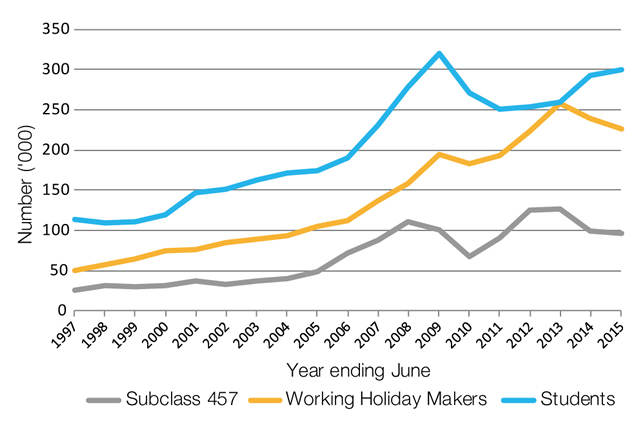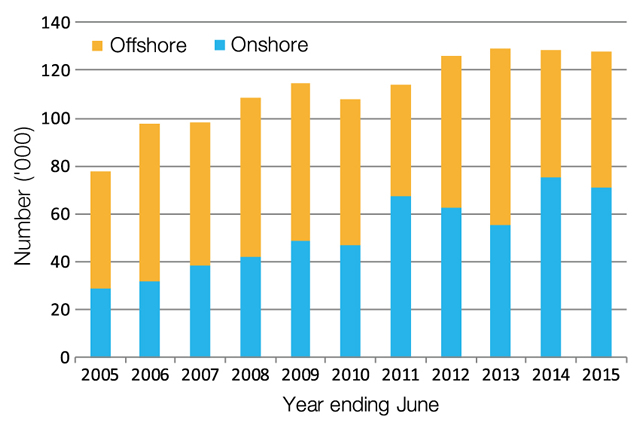Harriet Spinks, Social
Policy
Key Issue
Australia has a long tradition of immigration, and has for many years welcomed permanent migrants from all over the world under its managed migration program. Recent years have seen significant growth in the numbers of temporary migrants coming to Australia through uncapped, demand-driven programs such as the 457 visa program. There is an increasing trend for these temporary migrants to eventually settle here permanently.
Australia has a long history of welcoming migrants,
and has for many years run a highly managed permanent migration
program, with annual quotas for both skilled and family reunion migrants. In
2016–17 the migration program planning
level is for 190,000 places; where it has been for the last five years.
Around two-thirds of the permanent migration program is set aside for skilled migrants,
with the remaining third allocated to family reunion migrants. There is a
separate quota for the humanitarian program, discussed elsewhere in this
briefing book.
The last two decades have seen significant growth
in the numbers of temporary migrants coming to
Australia, the majority as either temporary skilled workers or overseas
students. This growth in temporary migration has led to what is perhaps the
most significant shift in immigration to Australia in the last 60 years—a move
to what is frequently termed ‘two-step migration’. Under this
process, migrants come to Australia initially on a temporary visa and then later
(potentially after many years) transition to permanent residency.
Temporary and two-step migration
Most of Australia’s long-term temporary migrants
come here as temporary skilled workers (on the subclass 457 visa), overseas students,
or working
holiday makers. Unlike the permanent migration program, for which annual
quotas apply, temporary migration categories are uncapped, demand-driven
programs. This means that numbers fluctuate each year according to the number
of people wishing to come to Australia and the number of overseas workers
needed by Australian business to fill local labour market gaps.
Figure 1: Visa grants to 457 visa workers,
overseas students and working holiday makers, 1996-97 to 2014-15

Source: J Phillips and J
Simon-Davies, Migration
to Australia: a quick guide to the statistics, Parliamentary
Library, 2016; J Phillips, Working
holiday makers in Australia: a quick guide, Parliamentary Library, 2016.
Immigration Department statistics indicate that increasing
numbers of temporary migrants are transitioning to permanent residency. Figure
2 shows the numbers of permanent skilled visas granted each year, over the last
ten years, to people who were offshore (outside Australia) at the time of visa
grant, and people who were onshore (in Australia on a temporary visa). During
this period the proportion of permanent skilled visas granted to people already
in Australia on a temporary visa has grown significantly.
Figure 2: Permanent skill stream visa
grants to offshore and onshore applicants, 2004-05 to 2014-15

Source: Department of Immigration and
Border Protection, Report
on the migration program (various years) and Population flows
(various years).
Policy considerations
This two-step migration process has many potential
benefits, and has been encouraged by successive governments as a means of
allowing Australia to ‘try
out’ potential migrants before allowing them to stay permanently. For the
migrants, it offers the chance to test out life in Australia before deciding
whether to make a permanent move.
However, there are also potential problems with
this process. There is evidence that temporary migrants are vulnerable to workplace
exploitation. The report
of a recent Senate Standing Committee inquiry into Australia’s
temporary work visa programs found that exploitation
was a serious problem for temporary migrants, and made several recommendations
aimed at improving the protection of temporary migrants in the workplace. The
Government had not formally responded to the report prior to the election.
The growth in the number of temporary migrants
coming to Australia has also caused concern
in some quarters about the impacts on the local labour market. Further concerns
relate to the settlement and integration of temporary migrants.
Recent reforms to the 457 visa program include
those made in response to a 2014 independent
review, which was tasked with investigating ways of improving the program’s
integrity while minimising the compliance burden on participating businesses. The
government agreed
to most of the review’s recommendations, and has implemented several of them to
date.
It is likely that temporary migration, and in
particular the 457 visa program, will continue to be the subject of debate and
reform, in response to ongoing concerns about how best to balance employers’
needs for migrant workers, with the protection of both local and overseas
workers.
Further reading
H Spinks, The temporary work (Skilled) (subclass 457) visa: a quick guide, Parliamentary Library, Canberra, 2016.
J Phillips, Working holiday makers in Australia: a quick guide, Parliamentary Library, Canberra, 2016.
J Phillips and J Simon-Davies,
Migration to Australia: a quick guide to the statistics, Parliamentary Library, Canberra, 2016.
Back to Parliamentary Library Briefing Book
For copyright reasons some linked items are only available to members of Parliament.
© Commonwealth of Australia

Creative Commons
With the exception of the Commonwealth Coat of Arms, and to the extent that copyright subsists in a third party, this publication, its logo and front page design are licensed under a Creative Commons Attribution-NonCommercial-NoDerivs 3.0 Australia licence.